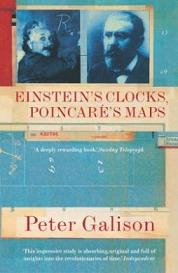
Einstein's Clocks, Poincare's Maps
In May 1905, Einstein published his theory of relativity, changing time forever. This title is a dramatic account of the quest to synchronize time that culminated in the revolutionary theory. As Galison argues, relativity was borne of urgent practical necessity. Clocks and trains, telegraphs and colonial conquest: the challenges of the late 19th century provided an indispensable real-world background to the theoretical breakthrough. Europe's burgeoning rail network. Only a century ago, the continent had hundred of time zones and no universal system for synchronizing them. Given that local time could vary from town to town, scheduling rail services was hard - but vital, not least to stop trains from colliding as they hurtled in opposite directions along singles tracks. In his role as president of the French Bureau of Longitude - a remit of which was to map colonial Africa - Henri Poincare grappled with a similar issue. Synchronized clocks, set by telegraph signal from Paris, were necessary to determine longitude and provide the precise coordinates his cartographers needed. to tell the story of these two giants - whose concrete preoccupations engaged them in a silent race towards a theory that overturned 200 years' received thinking...
note - fading to spine and foxing page edges.
